Theoretical and Experimental Investigations of Oxygen Activation Effect of Carbon Nanofibers Interacting with Polypyrrole
Abstract
:1. Introduction
2. Materials and Methods
2.1. Materials
2.2. Synthesis, Characterization, and Experimental Measurements
2.3. Theoretical Calculation
3. Results and Discussion
3.1. Morphology and Microstructure
3.2. Experimental Results
3.3. Theoretical Calculations of Molecular Modeling
3.4. Electrochemical Properties
4. Conclusions
Author Contributions
Funding
Data Availability Statement
Conflicts of Interest
References
- Yadav, D.; Amini, F.; Ehrmann, A. Recent advances in carbon nanofibers and their applications—A review. Eur. Polym. J. 2020, 138, 109963. [Google Scholar] [CrossRef]
- Altin, Y.; Bedeloglu, A.C. Flexible carbon nanofiber yarn electrodes for self-standing fiber supercapacitors. J. Ind. Text. 2022, 51 (Suppl. S3), 4254S–4267S. [Google Scholar] [CrossRef]
- Kundu, A.; Shetti, N.P.; Basu, S.; Mondal, K.; Sharma, A.; Aminabhavi, T.M. Versatile Carbon Nanofiber-Based Sensors. ACS Appl. Bio. Mater. 2022, 5, 4086–4102. [Google Scholar] [CrossRef]
- Soltani, S.; Khanian, N.; Shojaei, T.R.; Choong, T.S.Y.; Asim, N.; Zhao, Y. Recent trends in the design and engineering of incorporated carbon nanofiber nanocomposites and their advanced applications-A review. Mater. Chem. Phys. 2022, 286, 19. [Google Scholar] [CrossRef]
- Tan, S.; Li-Oakey, K.D. Effect of Structural Orientation on the Performance of Supercapacitor Electrodes from Electrospun Coal-Derived Carbon Nanofibers (CCNFs). J. Electrochem. Soc. 2019, 166, A3294. [Google Scholar] [CrossRef]
- da Silva, L.M.; de Lima Almeida, D.A.; Oishi, S.S.; Couto, A.B.; Ferreira, N.G. Constituent material influence on the electrochemical performance and supercapacitance of PAni/diamond/CF composite. Mater. Sci. Eng. B 2018, 228, 249–260. [Google Scholar] [CrossRef]
- Sassin, M.B.; Hoffmaster, A.N.; Österholm, A.M.; Lo, C.K.; Ko, J.S.; Reynolds, J.R.; Long, J.W. Integrating Solution-Processable Conducting Polymers in Carbon Fiber Paper: Scalable 3D Electrodes for Redox-Based Supercapacitors. ACS Appl. Polym. Mater. 2020, 2, 3234–3242. [Google Scholar] [CrossRef]
- Cherusseri, J.; Sambath Kumar, K.; Pandey, D.; Barrios, E.; Thomas, J. Vertically Aligned Graphene–Carbon Fiber Hybrid Electrodes with Superlong Cycling Stability for Flexible Supercapacitors. Small 2019, 15, 1902606. [Google Scholar] [CrossRef]
- Levitt, A.S.; Alhabeb, M.; Hatter, C.B.; Sarycheva, A.; Dion, G.; Gogotsi, Y. Electrospun MXene/carbon nanofibers as supercapacitor electrodes. J. Mater. Chem. A 2019, 7, 269–277. [Google Scholar] [CrossRef]
- Park, M.Y.; Kim, J.-H.; Kim, D.K.; Kim, C.G. Perspective on Carbon Fiber Woven Fabric Electrodes for Structural Batteries. Fiber Polym. 2018, 19, 599–606. [Google Scholar] [CrossRef]
- Xie, Y. Electrochemical Performance of Polyaniline Support on Electrochemical Activated Carbon Fiber. J. Mater. Eng. Perform. 2022, 31, 1949–1955. [Google Scholar] [CrossRef]
- Xie, Y. Electrochemical and hydrothermal activation of carbon fiber supercapacitor electrode. Fiber Polym. 2022, 23, 10–17. [Google Scholar] [CrossRef]
- Moosburger-Will, J.; Bauer, M.; Laukmanis, E.; Horny, R.; Wetjen, D.; Manske, T.; Schmidt-Stein, F.; Töpker, J.; Horn, S. Interaction between carbon fibers and polymer sizing: Influence of fiber surface chemistry and sizing reactivity. Appl. Surf. Sci. 2018, 439, 305–312. [Google Scholar] [CrossRef]
- Lee, J.Y.; Kim, B.J. Surface-Modified Activated Carbon Fibers by a Facile Microwave Technique for Enhancing Hydrocarbon Adsorption. Environments 2023, 10, 14. [Google Scholar] [CrossRef]
- Wang, Y.B.; Li, H.; Cui, B.W.; Xu, X.D.; Wang, Y.X. Simple Mixed-Acid-Treated Carbon Fiber Electrodes with Oxygen-Containing Functional Groups for Flexible Supercapacitors. J. Compos. Sci. 2023, 7, 15. [Google Scholar] [CrossRef]
- Qin, J.J.; Wang, C.G.; Lu, R.J.; Su, S.S.; Yao, Z.Q.; Zheng, L.B.; Gao, Q.; Wang, Y.X.; Wang, Q.F.; Wei, H.Z. Uniform growth of carbon nanotubes on carbon fiber cloth after surface oxidation treatment to enhance interfacial strength of composites. Compos. Sci. Technol. 2020, 195, 10. [Google Scholar] [CrossRef]
- Lee, Y.G.; An, G.H. Surface Functionalization of Carbon Fiber for High-Performance Fibrous Supercapacitor. Kor. J. Mater. Res. 2022, 32, 107–113. [Google Scholar] [CrossRef]
- Jung, H.Y.; Roh, S.H. Carbon Nanofiber/Polypyrrole Nanocomposite as Anode Material in Microbial Fuel Cells. J. Nanosci. Nanotechnol. 2017, 17, 5830–5833. [Google Scholar] [CrossRef]
- Dumanlı, A.G.; Erden, A.; Yürüm, Y. Development of supercapacitor active composites by electrochemical deposition of polypyrrole on carbon nanofibres. Polym. Bull. 2012, 68, 1395–1404. [Google Scholar] [CrossRef]
- Jain, R.; Jadon, N.; Pawaiya, A. Polypyrrole based next generation electrochemical sensors and biosensors: A review. TrAC Trends Anal. Chem. 2017, 97, 363–373. [Google Scholar] [CrossRef]
- Maduraiveeran, G.; Sasidharan, M.; Ganesan, V. Electrochemical sensor and biosensor platforms based on advanced nanomaterials for biological and biomedical applications. Biosens. Bioelectron. 2018, 103, 113–129. [Google Scholar] [CrossRef] [PubMed]
- Zhu, H.; Xie, Y. Electrochemical performance of bridge molecule-reinforced activated carbon fiber-m-aminobenzenesulfonic acid-polyaniline for braidable-supercapacitor application. Chem. Eng. J. 2023, 478, 147416. [Google Scholar] [CrossRef]
- Aryal, K.P.; Jeong, H.K. Electrochemical detection of ascorbic acid with chemically functionalized carbon nanofiber/beta-cyclodextrin composite. Chem. Phys. Lett. 2020, 757, 137881. [Google Scholar] [CrossRef]
- Yang, T.; Tian, X.D.; Song, Y.; Wu, S.J.; Wu, J.R.; Liu, Z.J. Oxygen-doped carbon nanofiber nonwovens as an effective interlayer towards accelerating electrochemical kinetics for lithium-sulfur battery. Appl. Surf. Sci. 2023, 611, 155690. [Google Scholar] [CrossRef]
- Cuevas-Muñiz, F.M.; Gurrola, M.P.; Tellez-Vázquez, O.; Esparza, R.; Guerra-Balcázar, M.; Arriaga, L.G.; Ledesma-García, J. Correlation between theoretical data and experimental selective properties of PtAg core-shell nanoparticles for oxygen reduction reactions. Int. J. Hydrogen Energy 2015, 40, 17284–17290. [Google Scholar] [CrossRef]
- Xie, Y. Simulation Calculation Verification of Graphene Oxide-Decorated Silver Nanoparticles Growing on Titania Nanotube Array as SERS Sensor Substrate. Chemosensors 2022, 10, 507. [Google Scholar] [CrossRef]
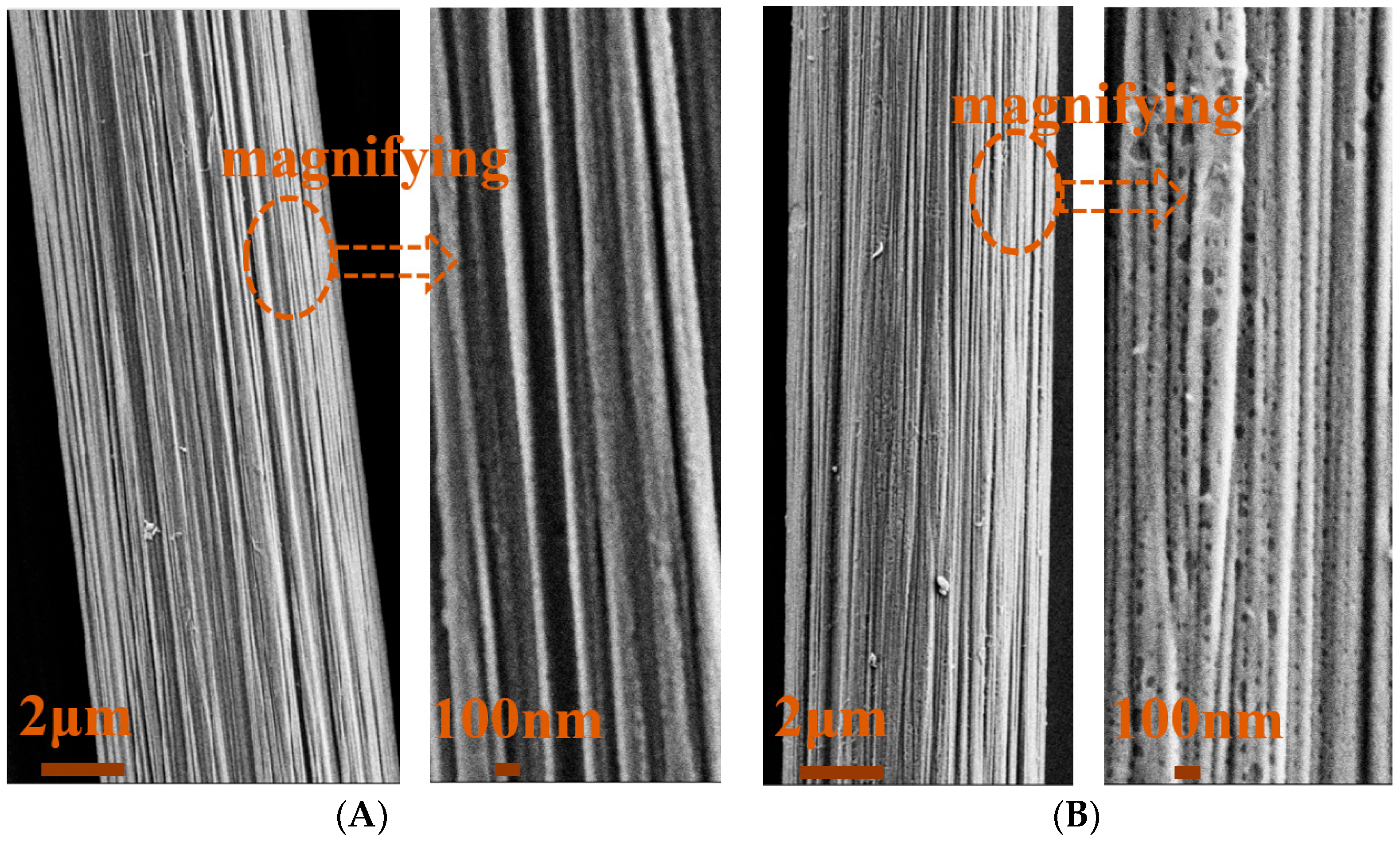
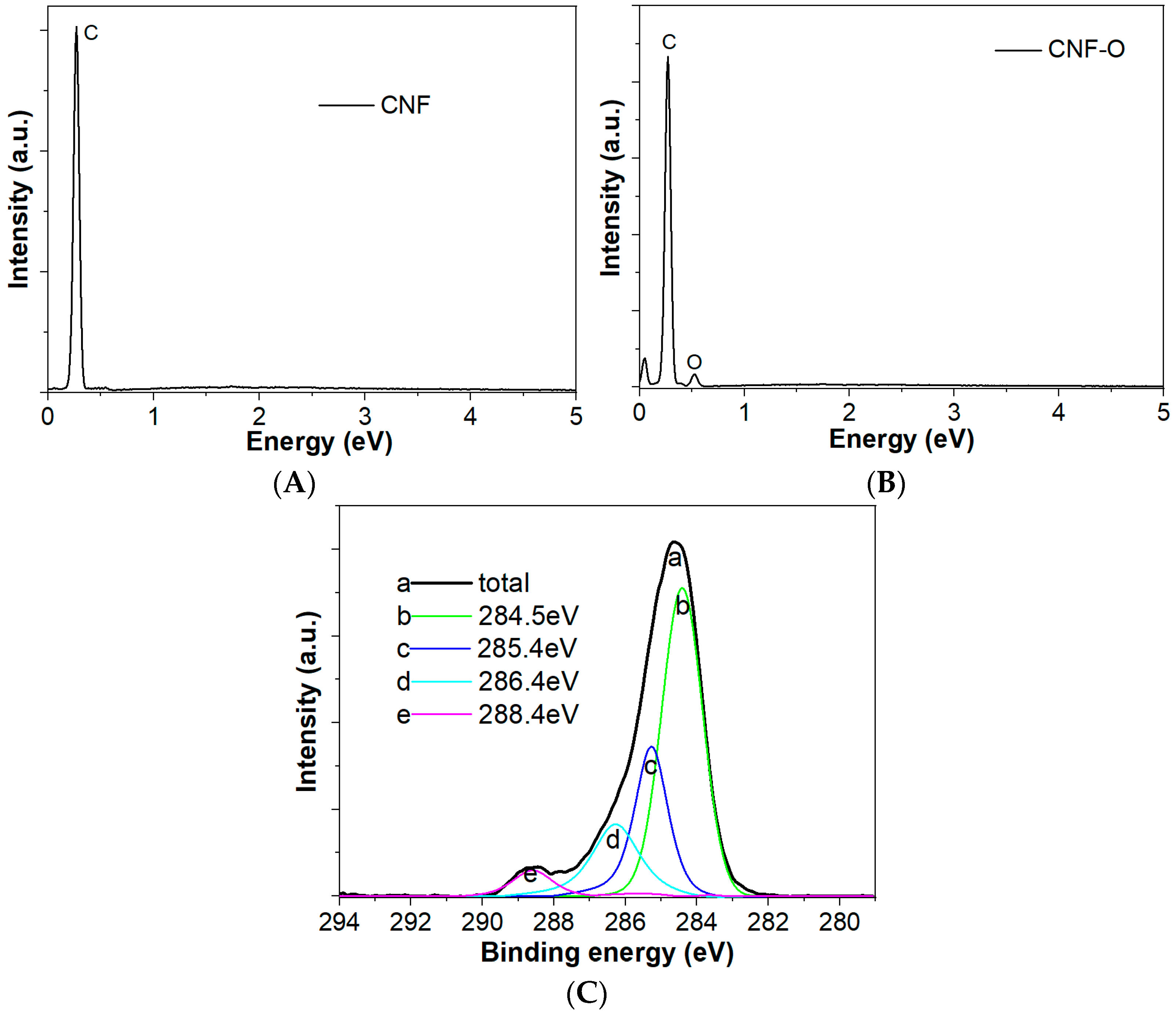
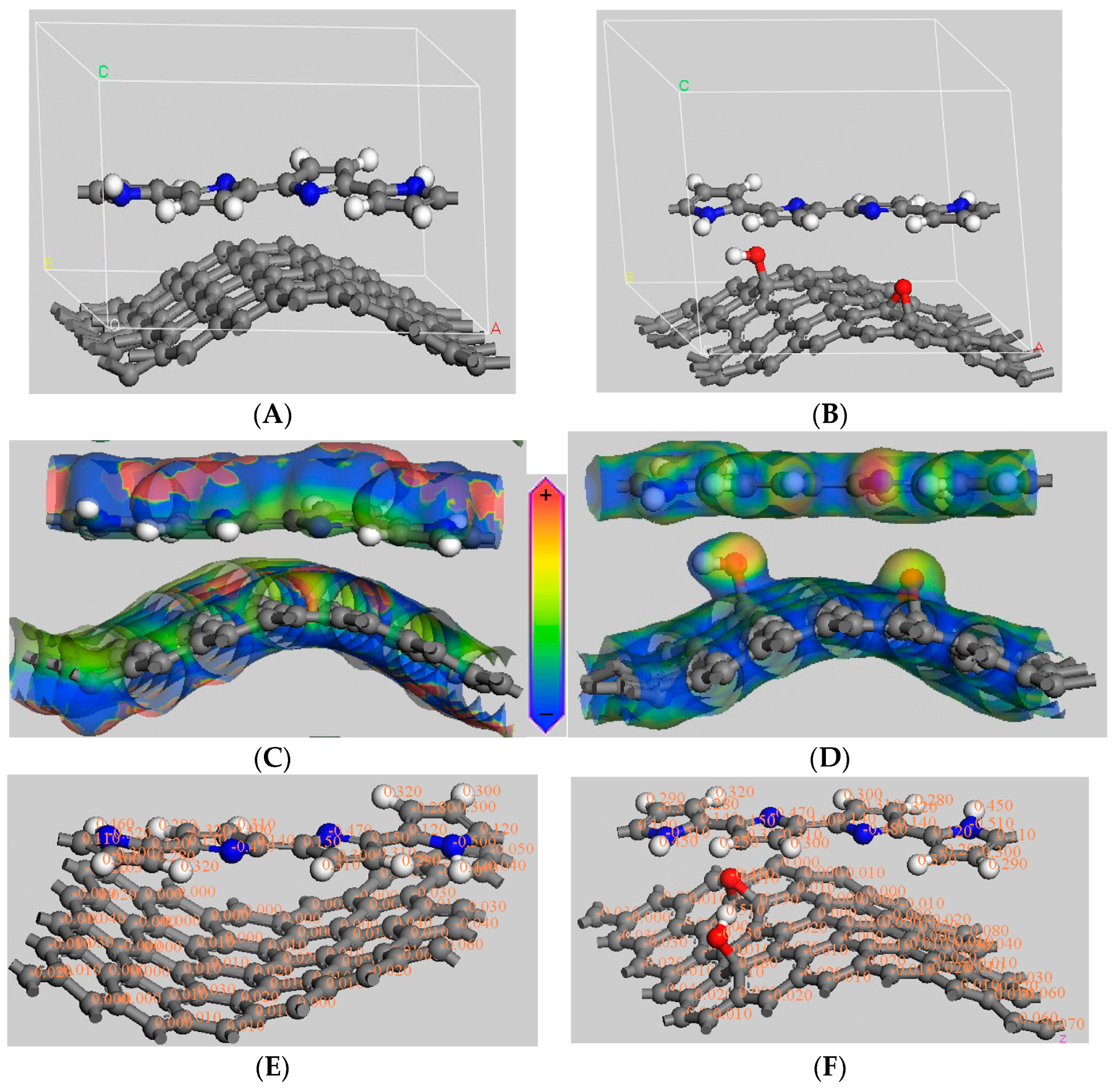
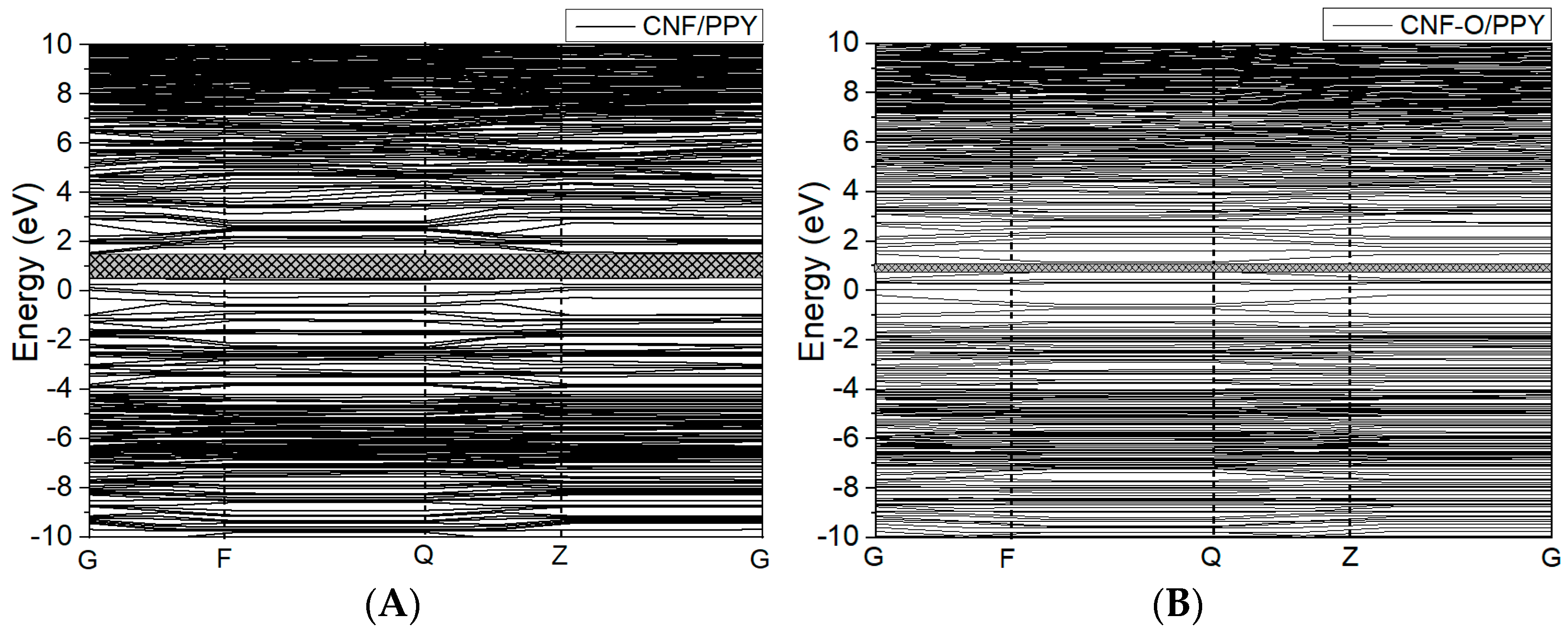

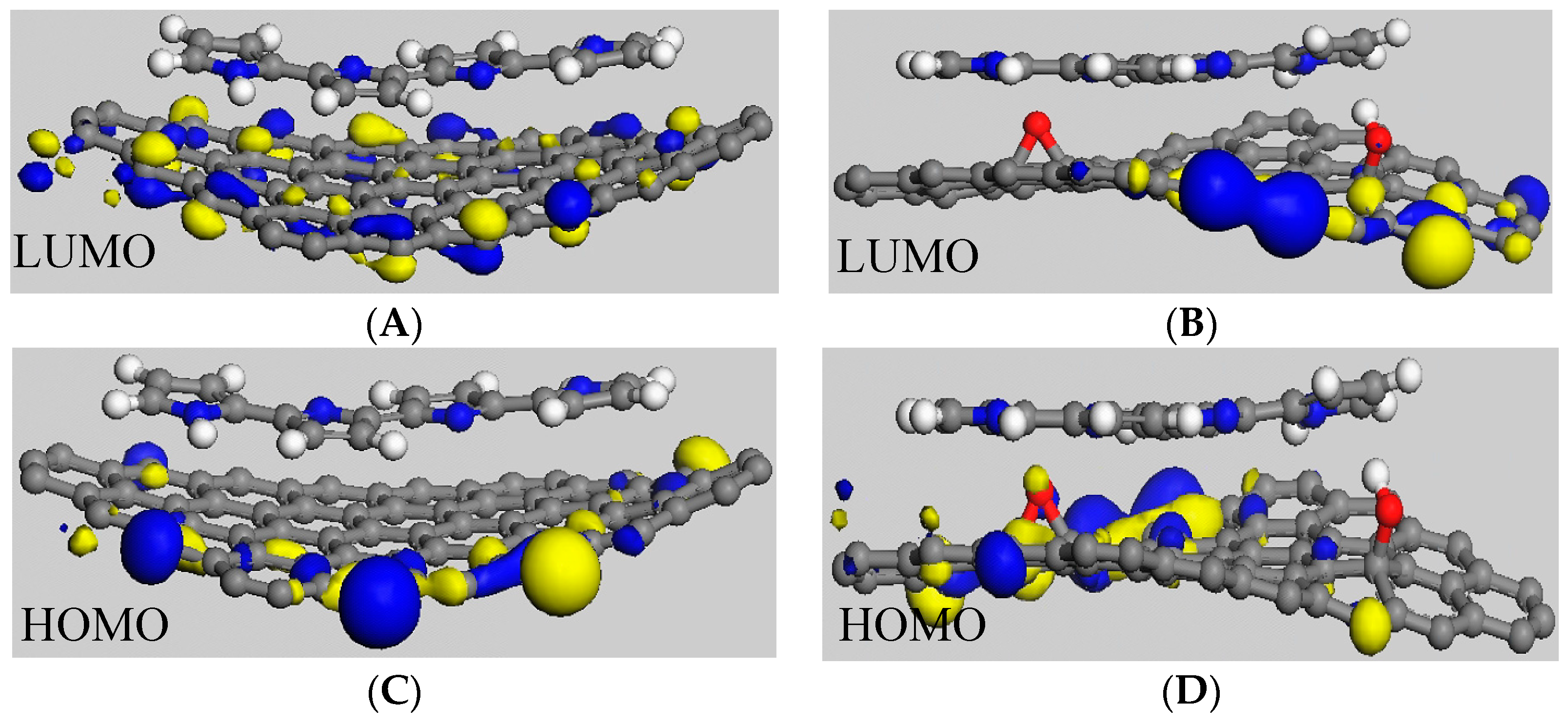

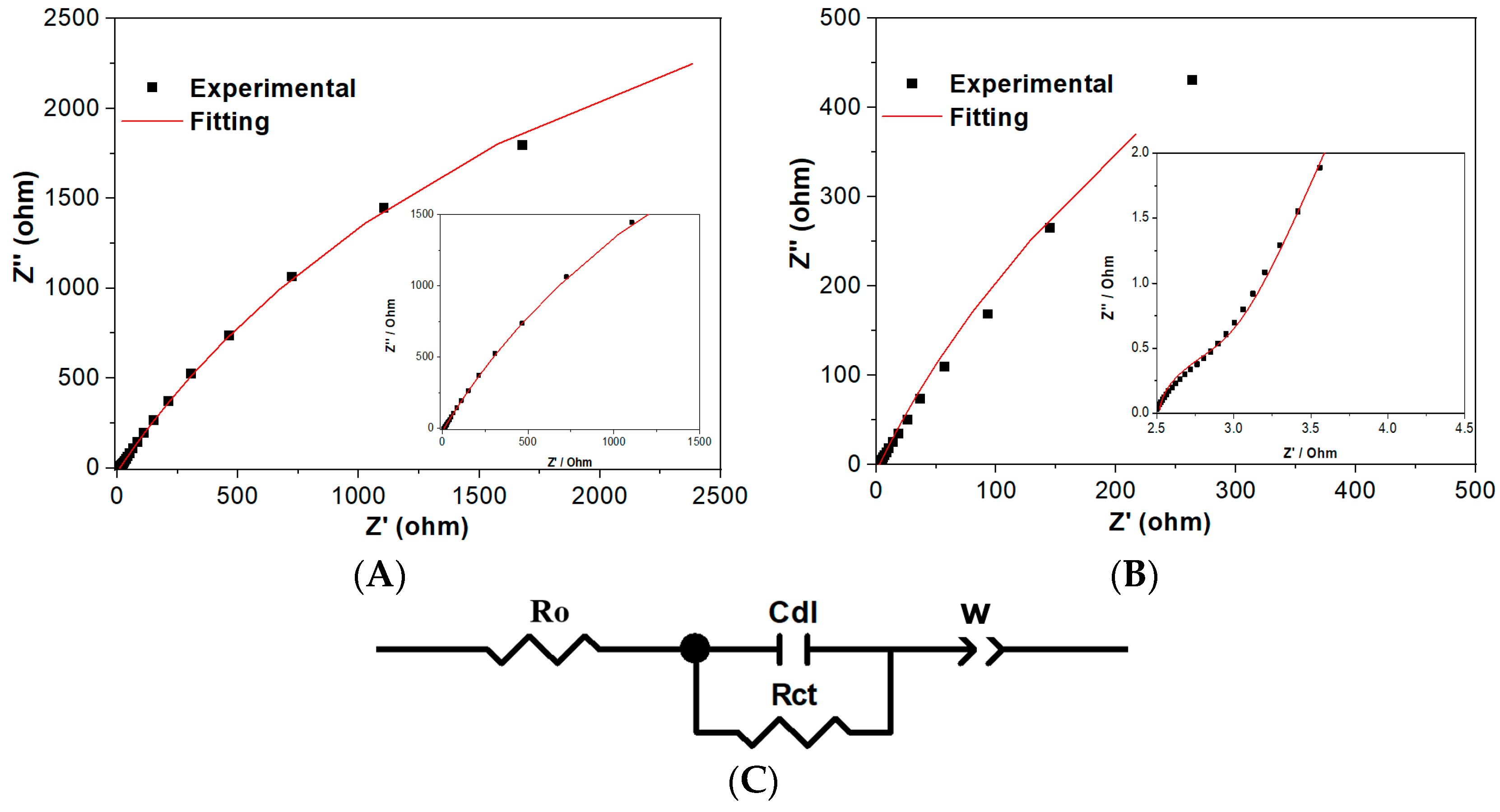
| Scan Rate (mV s−1) | 200 | 100 | 50 | 20 | 10 | 5 |
|---|---|---|---|---|---|---|
| CNF/PPY (mF g−1) | 24.2 | 27.4 | 32.1 | 39.4 | 46.2 | 57.6 |
| CNF-O/PPY (mF g−1) | 112.2 | 123.5 | 136.1 | 156.3 | 177.7 | 221.1 |
| Electrodes | Cdl (mF) | Rct (Ω) | Ro (Ω) | W (Ω) |
|---|---|---|---|---|
| CNF-O/PPY | 0.113 | 0.097 | 0.336 | 317 |
| CNF/PPY | 0.015 | 1.419 | 9.668 | 7865 |
Disclaimer/Publisher’s Note: The statements, opinions and data contained in all publications are solely those of the individual author(s) and contributor(s) and not of MDPI and/or the editor(s). MDPI and/or the editor(s) disclaim responsibility for any injury to people or property resulting from any ideas, methods, instructions or products referred to in the content. |
© 2023 by the authors. Licensee MDPI, Basel, Switzerland. This article is an open access article distributed under the terms and conditions of the Creative Commons Attribution (CC BY) license (https://creativecommons.org/licenses/by/4.0/).
Share and Cite
Xie, Y.; Wang, Y.; Wang, L.; Liang, J. Theoretical and Experimental Investigations of Oxygen Activation Effect of Carbon Nanofibers Interacting with Polypyrrole. Fibers 2024, 12, 4. https://doi.org/10.3390/fib12010004
Xie Y, Wang Y, Wang L, Liang J. Theoretical and Experimental Investigations of Oxygen Activation Effect of Carbon Nanofibers Interacting with Polypyrrole. Fibers. 2024; 12(1):4. https://doi.org/10.3390/fib12010004
Chicago/Turabian StyleXie, Yibing, Yiting Wang, Lijun Wang, and Jiawei Liang. 2024. "Theoretical and Experimental Investigations of Oxygen Activation Effect of Carbon Nanofibers Interacting with Polypyrrole" Fibers 12, no. 1: 4. https://doi.org/10.3390/fib12010004







